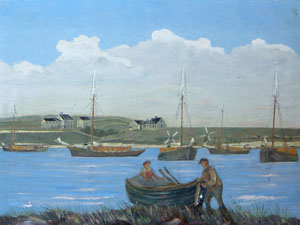
Historical Paintings of Woods Hole and Falmouth by F. L. Gifford
Scene in Little Harbor, 1845
(with salt works)
This view of Little Harbor is taken not far from the position of the U. S. Coast Guard Station. The windmills on the far shore pumped sea water into evaporating basins for the manufacture of crude salt for the fishing industry. Adjoining the salt works (54) on the left is Reuben Hamblin's house (39) and on the extreme left Simeon Hamblin's house and barn (38).
Salt making was an important industry in Woods Hole and Falmouth as in other parts of the Cape beginning at the time of the Revolution and for about a century thereafter because in 1776 the price of imported salt had soared to eight dollars per bushel. The long stretches of Cape Cod coast line were suitable for the erection of salt works, as well as being convenient to sources of lumber for vats. These factors combined to make the solar evaporation process the simplest and cheapest way at that time to provide the fishing fleet with the salt they needed to preserve their catches on "The Banks". It is recorded that the local price of salt made by evaporation ranged from seventeen cents to about one dollar per bushel and it was said that the waters around Cape Cod yielded about a bushel of salt for every 350 gallons of water.
In Woods Hole, the salt works extended along the shores of Little Harbor as shown in this picture. Scattered over the plain were windmills with canvas sails. Wooden rock-filled cribs were sunk offshore to hold down pipe lines of hollow logs through which the salt water was pumped to a storage tank high on the shore. A system of wooden pipes and troughs emptied into large wooden vats located along the shore. These vats with ponderous hinged wooden covers were about a rod square and about 10 inches high. About 8 inches of water was run into the first series of vats or water rooms, and exposed to the sun. As evaporation concentrated the brine it was led to a pickle room where further evaporation permitted salt crystals to form. The water was then conducted to a third vat or salt room where the precipitate of coarse yellow crystals was raked out.
During the process, the weather had to be watched carefully, for when it rained the lids of the vats had to be closed promptly to avoid dilution of the brine. Many small boys in town used to pray for rain in those days because they could earn small change by rushing to the salt works to help close the lids of the vats at the first sign of storm.
The text above, except where noted, is from Historical Paintings of Woods Hole, by Franklin Lewis Gifford (Woods Hole Public Library, 1962). The numbers in parentheses refer to Gifford's "Map of Woods Hole as of 1845," which you can see by clicking here.

